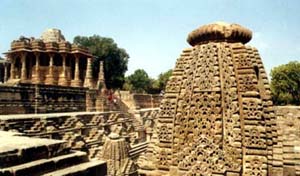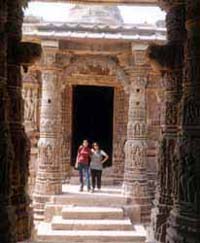| Heritage
|
|||||
A hectic work schedule at Arvind Mills implies that one hardly gets time to explore the exquisite and unblemished places in and around Ahmedabad. We decided enough was enough and set out for a trip to "Modhera" - The Sun Shrine. From Ahmedabad it is around 110 kms towards Mehsana. My wife Tanima and two friends Shalini and Samrat accompanied me on the trip that started at 10.30 a.m. in my Zen on 14th February 1999. We went straight towards Mehsana, a district near Ahmedabad. From the Mehsana main circle one has to take a left turn and go about 25 kms before one reaches "Surya Mandir" - that's what the locals call this place. The roads were well maintained, as all roads in Gujarat are. The last 25 Kms were particularly good: apart from a few herds on the way, there was absolutely no disturbance. The turban clad men driving the herds were a colorful sight, as the traditional dresses in Gujarat always are. The morning drive was very pleasant. During the drive I would slow down at several places to see if we could shoot some good pictures. Let me tell you here that Samrat and I are avid photographers. Well! we found that perfect spot. |
More on Gujarat • Ahmedabad,Baroda • Saurashtra - Part I • Saurashtra - Part II • Gir Sanctuary
Travelogues
Leisure | ||||
 Red-hot chilly peppers. This part of the country is famous for its "masala", the real stuff, not the Hindi film type, and here was a place where we found a chilly field. It was a beautiful sight. The entire ground was spread with chilies and the color was too exquisite for a photographer to leave unframed. We actually took quite a few shots, animated by the first vision of a chilly field.
Red-hot chilly peppers. This part of the country is famous for its "masala", the real stuff, not the Hindi film type, and here was a place where we found a chilly field. It was a beautiful sight. The entire ground was spread with chilies and the color was too exquisite for a photographer to leave unframed. We actually took quite a few shots, animated by the first vision of a chilly field.
When we reached "Surya Mandir" at 11.30 a.m. it was a grand sight indeed. To set this sublime temple in context, we must refer back in time to the Solanki dynasty of the 10th - 13th centuries. Built in 1026 A.D. during the reign of King Bhimdev I of the Solanki dynasty, the temple is dedicated to the Sun God. This temple, though ravaged by Mehmud of Gazni, still retains enough of it's original structure to convey the grandeur of its conception and the superb artistry of execution. Every inch of the edifice, both outside and inside is carved magnificently with motifs of gods and goddesses, birds, beasts and flowers . Modhera Sun Temple exemplifies the western Indian Solanki style: a shrine with cella approached from a mandapa or pillared open-planned hall. The halls have been created in such a manner that there is very little scope for light to enter it. Regrettably, at Modhera the shikhara is missing. The pitha or basement upper surface forms the floor of the temple. The outer decoration has a number of motifs engraved.
It aggrieved me that some portion of this exquisite site was ruined - by nature or by vandals - I don't know. Some portions were obviously restored and noticeably different to the original work but nevertheless at least it says that someone is trying to maintain our historical heritage. The Sun Temple at Konark near Puri and Modhera are completely different from each other. The architecture here is more exquisite from that of Konark, which I had visited in 1996. Also, Konark was never completed and was never used for worship, whereas the temple here has known the vibrations of worship.
At Modhera the inside There is actually a small temple beside the sun temple, built more recently, where people offer "puja". It is a temple of Shiva. That day being Shivratri, it was particularly significant. There is also a small Archeological Museum beside the temple. It is simple but on display are some of the broken pieces from the original temple. There is a motif of Durga and Ganesh and many other deities. An adjacent small garden provides a cool resting-place. We were planning to go to Patan from here, the town famous for "patola" sarees. But it seemed that the sun god wanted us to return home instead. Exhausted from the heat, we headed homewards. (Photo Credit: Sanjay Roy Chowdhury & Somrat Som) |
|||||
Editor: Romola Butalia (c) India Travelogue. All rights reserved. |
|||||

 Above the pitha level of conventional reliefs comes the mandovara, the main area for artistic expression, displayed not only on the wall face, but also in niches. A range of deities and their vehicles, associated angels, maidens, animals and holy men adorn the walls in splendid array from high to low relief.
In front of the temple is a vast rectangular stepped tank with niches all around. It almost eclipses the temple in it's scale. This is a water reservoir. When we went it was stark dry but during the monsoons it fills up. I would say we were lucky that this tank was not filled with water, or we would have missed the grandeur of the sight. This tank would be about two stories deep with steps all around. There are four small shrines on four sides of the tank. The motifs inside the tanks were also extraordinary.
Above the pitha level of conventional reliefs comes the mandovara, the main area for artistic expression, displayed not only on the wall face, but also in niches. A range of deities and their vehicles, associated angels, maidens, animals and holy men adorn the walls in splendid array from high to low relief.
In front of the temple is a vast rectangular stepped tank with niches all around. It almost eclipses the temple in it's scale. This is a water reservoir. When we went it was stark dry but during the monsoons it fills up. I would say we were lucky that this tank was not filled with water, or we would have missed the grandeur of the sight. This tank would be about two stories deep with steps all around. There are four small shrines on four sides of the tank. The motifs inside the tanks were also extraordinary.
 of the temple is very dark, and one almost needs artificial light to carefully see the motifs. The inner sanctum, which housed the presiding deity, the sun god, faces east and is so designed that at solar equinoxes the first rays of the rising sun light up the image of the "surya" - the sun god. Although we did not see that but the imagination of it was enchanting.
of the temple is very dark, and one almost needs artificial light to carefully see the motifs. The inner sanctum, which housed the presiding deity, the sun god, faces east and is so designed that at solar equinoxes the first rays of the rising sun light up the image of the "surya" - the sun god. Although we did not see that but the imagination of it was enchanting.